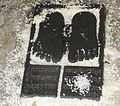Aranatha
| Aranatha | |
|---|---|
 The idol of Tirthankara Aranatha in a Jinalaya at Amritsar, Punjab. | |
| Venerated in | Jainism |
| Predecessor | Kunthunatha |
| Successor | Mallinatha |
| Symbol | Fish [1] |
| Height | 30 Bows (90 Metres) |
| Age | 84,000+ |
| Color | Golden |
| Personal information | |
| Born | |
| Died | |
| Parents |
|
| Dynasty | Ikshvaku dynasty |
| Part of a series on |
| Jainism |
|---|
 |
Aranath(Arnath) was the eighteenth
Ikshvaku dynasty.[2]
His birth date was the tenth day of the Migsar Krishna month of the Indian calendar.
Life
Like all other
Chakravartin, he also conquered all the lands[3] and went to write his name on the foothills of mountains. Seeing the names of other Chakravartin already there, he saw his ambitions dwarfed. He then renounced his throne and became an ascetic for penance.[3] At an age over 84,000 years he and attained Moksha (liberation) on Mount Shikharji.[3]
Worship
Svayambhūstotra by O Passionless Lord Aranatha! Your physical form which is free from all vestiges of ornaments, clothes and weapons, and the embodiment of unalloyed knowledge, control of the senses, and benevolence, is a clear indication that you have vanquished all blemishes.Acarya Samantabhadra is the adoration of twenty-four tirthankaras. Twenty slokas (aphorisms) of Svayambhūstotra are dedicated to Tirthankar Aranath.[4] One such sloka is:
— Svayambhustotra (18-2-12)[5]As a historical figure
At
Suparśvanātha.[6]
Temples
- Navagarh Tirth
- Munisuvratnath.[7]
- Prachin Bada Mandir, Hastinapur, Uttar Pradesh
-
Chaturmukha basadi (Karnataka) dedicated to Tirthankara Aranath
-
Jain temple dedicated to Tirthankar Aranath
-
Prachin Bada Mandir, Hastinapur
-
Footprints at Aranath Tonk,Shikhar Ji
See also
Wikimedia Commons has media related to Aranatha.
References
- ^ Tandon 2002, p. 45.
- ^ a b Tukol 1980, p. 31.
- ^ a b c d von Glasenapp 1999, p. 308.
- ^ Vijay K. Jain 2015, p. 118-129.
- ^ Vijay K. Jain 2015, p. 122.
- ^ Jain 2009, p. 77.
- ^ Sandhya, C D’Souza (19 November 2010), "Chaturmukha Basadi: Four doors to divinity Last updated", Deccan Herald
Sources
- Johnson, Helen M. (1931), Aranathacaritra (Book 6.2 of the Trishashti Shalaka Purusha Caritra), Baroda Oriental Institute
- Jain, Vijay K. (2015), Acarya Samantabhadra's Svayambhustotra: Adoration of The Twenty-four Tirthankara, Vikalp Printers, ISBN 978-81-903639-7-6, archived from the original on 16 September 2015,.
 This article incorporates text from this source, which is in the public domain
This article incorporates text from this source, which is in the public domain - Jain, Arun Kumar (2009). Faith & philosophy of Jainism. Delhi, India: Kalpaz Publications. ISBN 9788178357232.
- University of Karnataka
- ISBN 81-208-1376-6
- Tandon, Om Prakash (2002) [1968], Jaina Shrines in India (1 ed.), ISBN 81-230-1013-3




